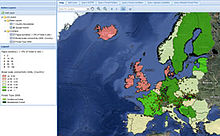Open data portal of the EU
|
|
|
|---|---|
| Public service portal and institutional information | |
| languages | 24 official EU languages |
| operator |
|
| editorial staff | Publications Office of the European Union |
| Registration | not mandatory |
| On-line | December 2012 (currently active) |
| http://data.europa.eu/euodp/de | |
The EU's open data portal offers central access to data from institutions, agencies and other bodies of the EU. The portal is a core part of the EU's open data strategy. The portal is an important tool in the EU's open data strategy. The free and easy access means that the data can be used innovatively and develop greater economic potential. The aim of the portal is also to increase the transparency of the EU institutions and bodies and thus to make them more comprehensible.
Legal basis and start
The portal was officially set up by the Commission Decision of December 12, 2011 (2011/833 / EU) on the re-use of Commission documents in order to promote accessibility and re-use, and opened in beta mode in December 2012. While the technical management of the portal is the responsibility of the Publications Office of the European Union , the Directorate-General for Communication Networks, Content and Technologies of the European Commission is responsible for the implementation of the EU's open data policy.
Functions
Using a catalog of shared metadata, the data can be located, searched, linked, downloaded and used for commercial or non-commercial purposes. This catalog enables access to data stored on the websites of the institutions, agencies and other bodies of the EU. Semantic technologies offer new functions. The metadata catalog can be searched using an interactive search engine (“Data” tab) and using the SPARQL search (“Linked data” tab). The portal also offers access to visualization applications from various institutions, agencies and other EU bodies.
Users can suggest data sets that are to be linked to the portal, comment on the quality of the available data and exchange information with other users about the use of the portal.
Access itself is possible in 24 official EU languages, whereas most metadata is currently only available in German, English and French. Some metadata (e.g. names of data providers, geographic coverage) are available in 24 languages thanks to the translation of controlled word lists used by the portal .
Terms of Use
Most of the data accessible via the EU's open data portal fall under the legal notice on “Europe” and can be used free of charge for commercial and non-commercial purposes provided the source is indicated. Some of the data are subject to special conditions for further use, which differ mainly in the protection of the intellectual property rights of third parties.
Available dates
The portal contains a wide variety of high quality open data from all EU policy areas (economy, employment, science, environment, education, etc.). This was recently noted in the G8 Open Data Charter.
To date, around 70 institutions, facilities and services (e.g. Eurostat , the European Environment Agency, the Joint Research Center and other Directorates-General of the European Commission and EU agencies) have provided a total of more than 11,700 data sets.
In addition to access to data sets, the portal offers easy access to a range of visualization applications based on EU data. These applications are provided for informational purposes and provide examples of what kind of applications can be built using the data.

Structure of the portal
The portal is based on open source solutions such as the content management system (CMS) Drupal and CKAN , the data catalog software developed by the Open Knowledge Foundation . It uses Virtuoso as a resource description framework and has a SPARQL endpoint.
Its metadata catalog is based on international standards such as the Dublin Core , the data catalog vocabulary DCAT and the ADMS .
See also
Web links
- Europe 2020 - Official EU site
- Communication from the Commission Open Data: A motor for innovation, growth and transparent governance
- Data catalogs


